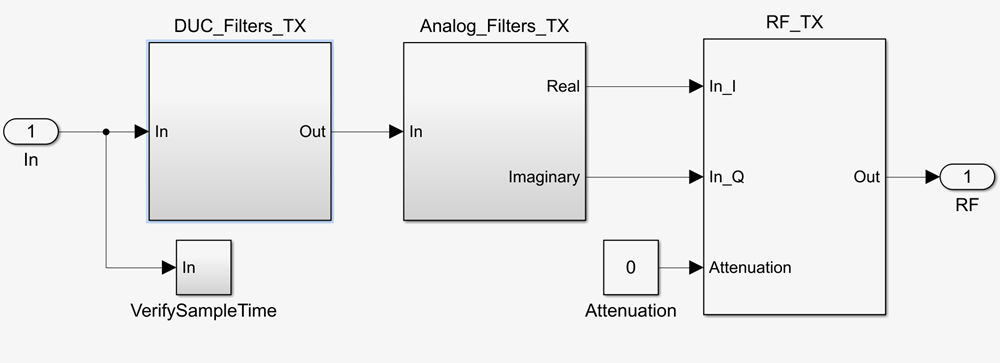AD9361 Models
You can use the AD9361 models to simulate Analog Devices® AD9361 RF transmitter or receiver designs. These models also helps to see the impact of RF imperfections on your transmitted or received signal.
Install Analog Devices RF Transceivers using, simrfSupportPackages. You can open models
using the Simulink® Library Browser and opening RF Blockset™ Models
for Analog Devices RF Transceivers, or by typing the following
in the MATLAB® command prompt:
open ad9361_modelsChoose the model you want from the library:

Note
You require these additional licenses to run this model:
Communications Toolbox™
Stateflow®
Fixed-Point Designer™
Complete documentation on how to use the models is available with the software download.
open(ad93xx_getdoc)
AD9361_TX Analog Devices Transmitter
Model Description

The transmitter model consists of three stages:
Digital up-conversion filters (DUC_Filters_TX))
Analog filters (Analog_Filters_TX)
RF front end (RF_TX)
You can use the transmitter model to simulate the following behaviors:
Tunable attenuation
Oscillator phase noise
Carrier-dependent noise floor
Attenuation and carrier-dependent nonlinearities like output-referred third-order intercept (OIP3)
Attenuation dependent gain imbalance
Attenuation dependent local oscillator (LO) carrier leak
AD9361_RX Analog Devices Receiver
Model Description

The receiver model consists of:
RF receiver (RF_RX)
Analog filters (Analog_Filters_RX)
Analog to Digital Converter (ADC_RX)
Digital down-conversion filters (DDC)
Receiver signal strength indicators
Automatic gain control (AGC) state machine
Gain table
You can use the receiver model to simulate the following behaviors:
Tunable low-noise amplifier, mixer, and trans-impedance amplifier (LMT) gains
Carrier-dependent noise floor
Gain and carrier-frequency dependent nonlinearities like output-referred third-order intercept (OIP3)
Gain and carrier-frequency dependent nonlinearities like output–referred second–order intercept (OIP2)
Gain dependent gain imbalance
Gain dependent local oscillator (LO) carrier leak